Please view these information tabs to help get Mechanical Clock Hands.
Removing Mechanical Clock Hands
Removing Mechanical Clock Hands is fast and easy to do. The following are hand removal instructions for German mechanical movements post WW2.
German Post WW2 wall, mantle and floor models
Removing mechanical clock hands for post WW2, mantle and floor clocks is quite simple. Turn the hand nut to the left while holding the minute hand with your fingers.
Use some small needle nose pliers to loosen the nut first. Once the nut is loose, turn it with your fingers until it comes off.
Then the minute hand will be able to wiggle straight off its square arbor and off of the clock. The hour hand is a friction fit, so just twist the hour hand back and forth and pull toward you until it comes off.
If having a second hand bit, that is only a friction also, so just grab it with your fingernails, twist and pull off.
American Antique time and strike
These type of movements come in two styles. If there is a minute hand nut, the first style is the same as above.
Be very careful not to lose this hand nut. They are very hard to find and replace. The second style of mechanical clock hands will have a pin holding the minute hand on instead of a nut.
This pin tapers, meaning it's fat on one side and skinny on the other. Just grab the fat side with needle nose pliers and yank the pin out. The minute hand will fall out with a washer.
Save the washer and the tapered pin for ease of reinstalling the hands. If these items happen to get lost, Clockworks offers washers and taper pins for purchase, as well as replacement mechanical clock hands.
German Mechanical-Clock Hand Installation
The installation of a German Mechanical-Clock Hand on a German mechanical movement is quite simple. It is simply the opposite of the removal process.
The minute hand must go through some adjustments if you are replacing the movement. Also if the hands are new. This is so it will point to the correct time when it chimes.
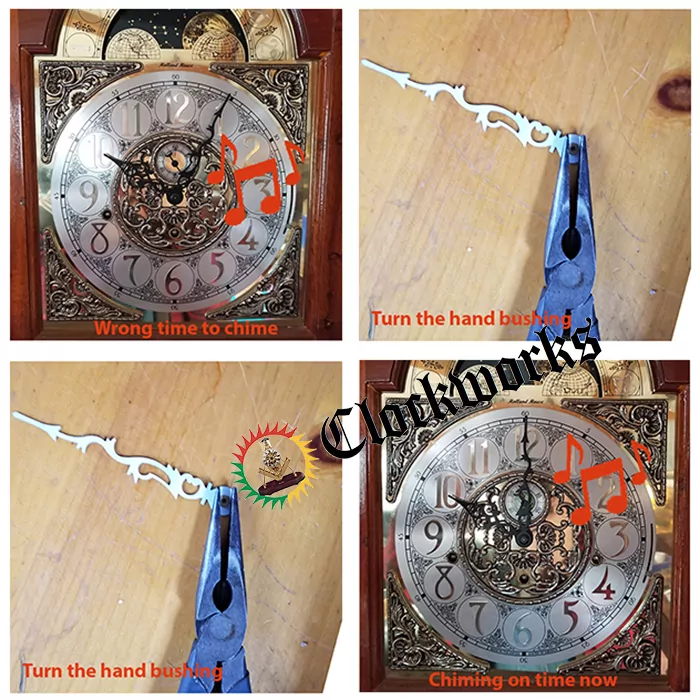
Installing the hour hand
First comes the hour hand. The hour hand is simply a friction fit. All you have to do is put the hand on its round post. Then twist and push toward the front of the dial.
Make sure that it is not in contact with the dial at any point during the rotation.
This includes the base of the hour hand. It cannot rub against the hole that is in the clock face. So, the clock can stop at any point if the hour hand touches anything. You can turn the hand to point to whatever hour it is because it is only a friction fit.
Installing the minute hand
Second, comes the minute hand. Install the minute hand by lining up the the square hole in the hand with the square post of the hand shaft. The bottom of the minute hand cannot be rubbing the hour hand tube or the hour hand. Push the hour hand down further onto the tube if the minute hand is rubbing.
Therefore, it is imperative to check the positioning of the hands to ensure they are not touching anything. Once the minute hand is on its square post, it's time to put the hand nut on.
Tighten the nut with your fingers and then use a pair of needle nose pliers to make it secure. It does not have to be extremely tight. However you need to ensure it is tight enough so that the hands do not come loose as they go around the clock.
Mechanical Clock Hands
German mechanical clock hands are sold by the time track diameter. This measurement is important when ordering these mechanical clock hands. To clarify, the dial diameter is the measurement of the time track.
This means from just outside the 9 straight across to just outside the 3. For example, if the time track diameter is 6 inches, then select hands for a 6 inch time track in the drop down list. Hands for a 6 inch time track will have a minute hand of about 2 7/8 long from the mounting hole to the end.
The hour hand, which is proportionally smaller, will come with the minute hand. This measurement is vastly different than the way you measure quartz clock hands. So be sure to follow these directions for measuring and not the ones for the quartz hands.
Ordering Hands
Choose a style of mechanical hands after getting the time track diameter. There is a drop down menu under each style of hand. Look to see if the style comes in the size you need for the clock.
Not all styles of hands come in the same sizes. So you have to look at the different options available. Serpentine and spade are the most popular mechanical clock hand styles.
Remember, the minute hand will be a little less than half of the time track measurement. The hour hand will be proportional in size to the minute hand.
How they are sent
So, when ordering mechanical clock hands, remember that they come as a pair, hour and minute hand. They ship the next business day from Clockworks in Huntington MA USA, via the method that is chosen upon checkout.
Mechanical Clock Chime On Time
These are the directions to get a German mechanical clock to chime on time. This means having the clock hands point to the right spot when the clock chimes.
When replacing a clock movement, or getting new clock hands, either one, you will notice it will chime 5 minutes before it should, or 10 min after, something like this. This page explains how to correct this situation. It is unbelievably fast and easy to do.
Working with the minute hand
After the installation of a new mechanical movement , or if you are just installing a new set of hands, you may notice the clock will not chime at the time it should.
To correct this, take the minute hand off of the clock. This is the longer of the two hands.
With this minute hand off of the clock, turn it upside down and look that it has a square hole where it attaches to the clock. This square hole is in a bushing that will rotate WITHIN the minute hand itself.
The correction
So, all to be done is just use needle nose pliers to turn this bushing ever so slightly. Put the hand back on the clock and see if it’s pointing to the correct place where it should chime.
If it is, then it all set and it will point to the exact place it should be pointing to. If it is still not right, take the hand off and try again. Once you get the minute hand to point to the correct chime you then set it to the correct time.
The conclusion
It is really that easy, there is nothing to do with the clock itself, only the minute hand. In other words, to put it in a silly way, take the minute hand off of the clock and walk to the garage with it.
Take it far, far away from the clock. When in your garage take needle nose pliers and turn the bushing within the hand itself. Then walk back to the clock and put it on. See if it's now pointing to the right spot.
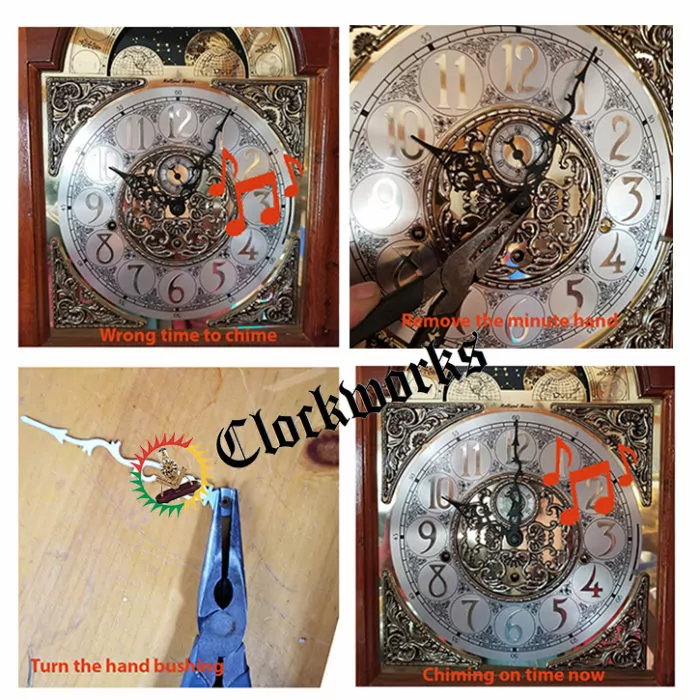
Mechanical clock hand nuts
One of the most common parts a Mechanical clock needs is the hand nut. As we said before, the older the clock the harder things are to find. So, the hand nuts Clockworks offer are for movements made after the 1930's.
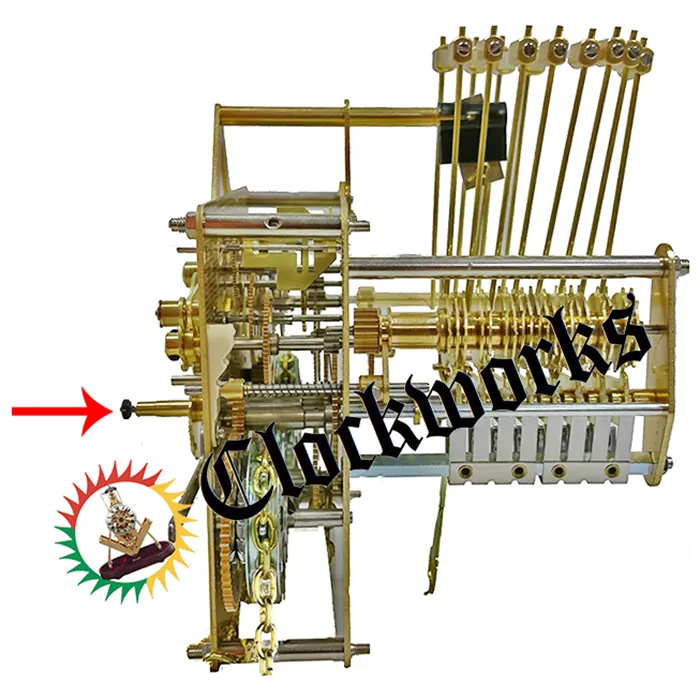
Prior to 1930 clock hand nuts
There were not many standards on what the hand nut size should be on the early clocks. However, prior to around 1930 there is no telling what will work. In other words, it is literally trial and error. There was no standard hand nut size.
Subsequently, any hand nut we offer, may, or may not, work. This includes cuckoo hand nuts, American clock hand nuts, or German hand nuts. However, with even all of these assortments, there is a chance none of them will work on the clock.
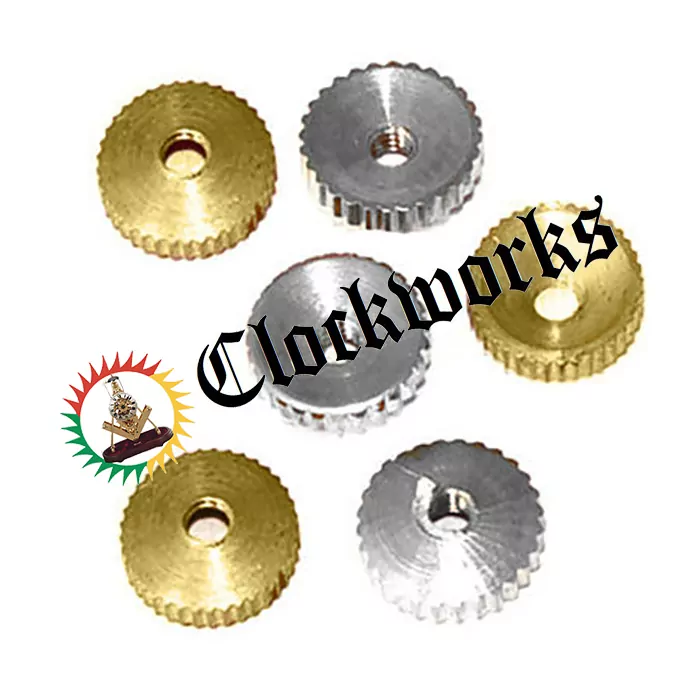
Post 1930 clock hand nuts
Generally speaking, what we have to offer in the three types of clock hand nuts will cover most of the post 1930 Mechanical clocks.
The cuckoo hand nuts fit about 80% of the post war German made cuckoo clocks.
So, the American clock hand nuts fit many of the mechanical time strikes that were so popular. German hand nuts fit most post war German made mechanical clocks, with the exception being a few large grandfather clocks.
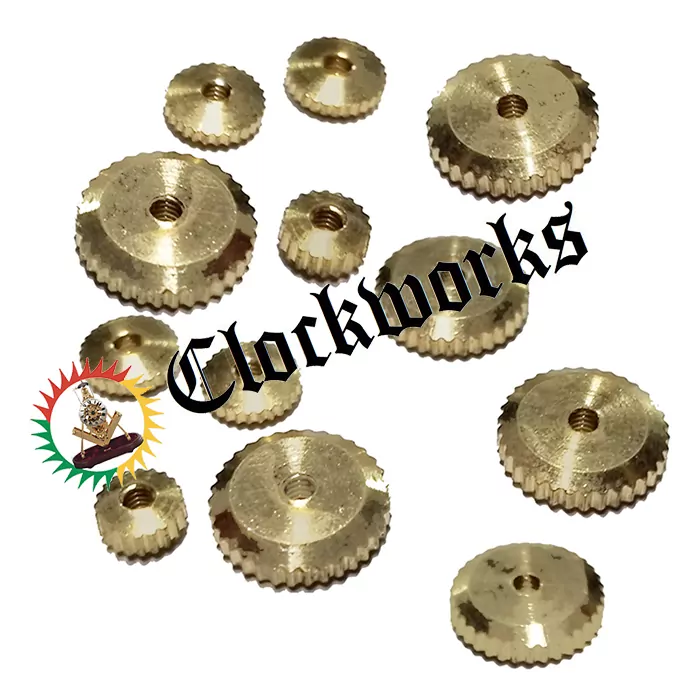
Clocks that do not take a hand nut
However, not all clocks require a hand nut. Some antique mechanical clocks require a clock hand washer and a tapered pin instead. These secure the minute hand as an alternative to the hand nut.
The washer may have a small square hole, or large, oblong or round hole. Clockworks offers an assortment of 100 clock hand washers that includes all the styles above. Use a taper pin to secure the hand with the washer on top of it.
Insert the taper pin into the hole in the end of the minute hand arbor to secure the washer and minute hand to the clock. A taper pin is a small brass or steel rod that is wide on one end and skinny on the other. Clockworks offers them in an assortment of 100 to ensure the right one is there.
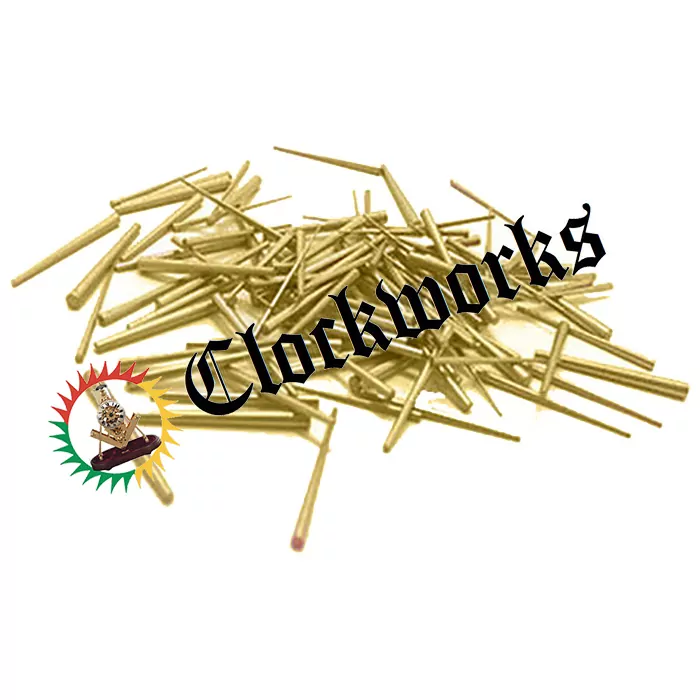
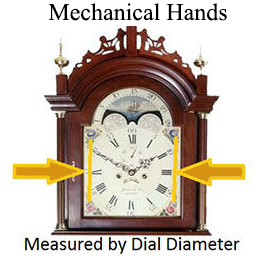
ST hands
Hands that have an ST on them to represent the Seth Thomas company. For antique 8 day time strike units made in USA. Fits most American antique movements such as ST, Sessions, New Haven, Ansonia, Gilbert, and Waterbury. These hands have a 4mm wide square mounting hole.
Each set includes an hour hand and a matching minute hand. The hour hand has a round mounting hole with a brass sleeve and is proportionally shorter than the minute hand.
Fits many but not all
While not guaranteed to fit, these parts frequently fix the problem. Remember, older clock movements used diverse standards, making compatibility a bit tricky.

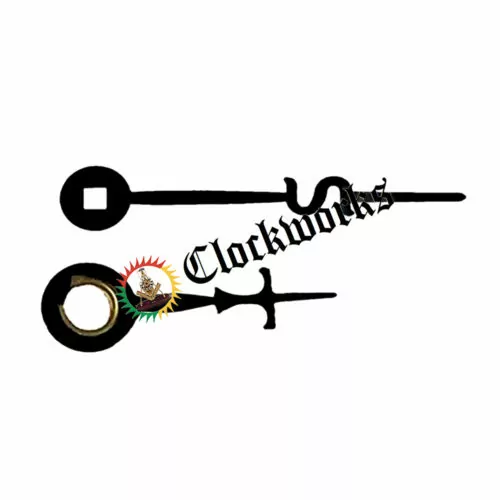
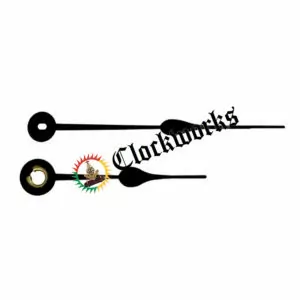
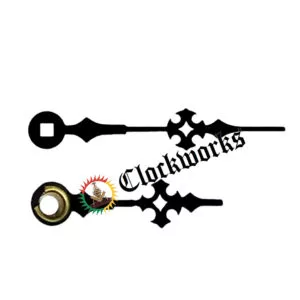
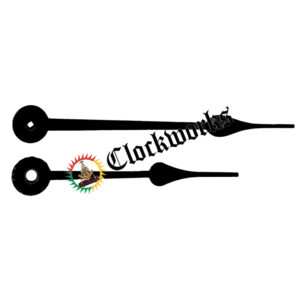
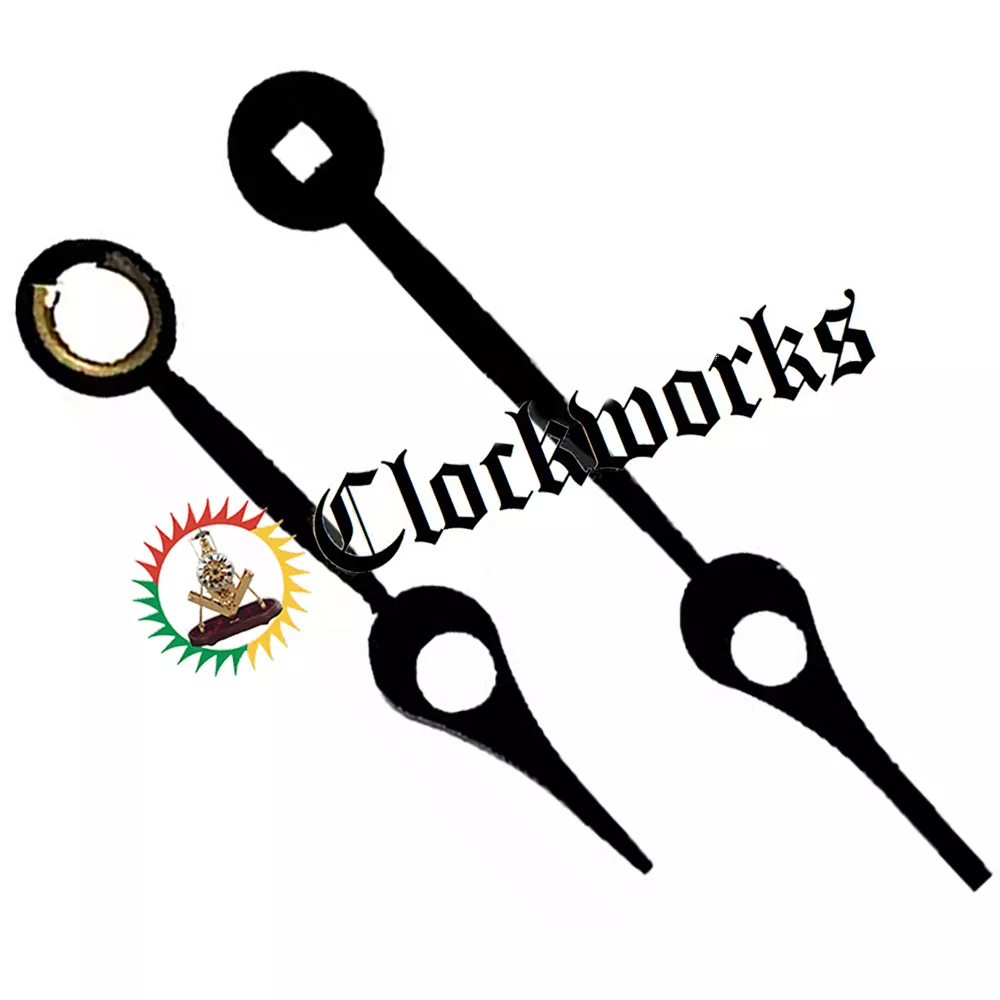











I have a Seth Thomas Adamantine (Red) clock (89c movement with only the 4-1/2 stamped on it, but no other ID marks, so I think it is an older of the 89 movements). I inherited from my parent’s attic decades ago in very rough condition, no glass or hands, and no back panel. Dust and dirt prevailed! . I’ve recently cleaned it, constructed a new back panel for it, and it has been running for a few days now. I am ordering glass and hands for it from Clockworks. It is great that these items are still available.
I noticed that on this clock, that the 5 -1/2″ hour hand mounts with a push on friction fit to the outer shaft, and the minute had has a square hole mounted to the square inner shaft with the taper pin to hold it on.
Also among my parts for mounting the hands are a small, very thin non metallic washer and a small spring that is about 3/16ths of an inch in depth. I believe the spring and washer are meant to be between the two hands with the spring putting a tiny bit of pressure on the back side of the minute hand keeping it against the taper pin, and to keep it away from the pressed on hour hand. I guess that the washer is there to keep the spring from snagging or interfering with the hour hand.
Do I have this right?
Thanks for your help and advice.
Correct.
Spade hands =
https://www.clockworks.com/product/spade-clock-hands-american
Taper pins =
https://www.clockworks.com/product/clock-repair-tapered-pins
Hand washers =
https://www.clockworks.com/product/clock-hand-washer-assortment
James Stoudenmire
40yr Clockmaker
Author of Clockworks.com
Clockworks Inc
http://www.clockworks.com
124 Goss Hill
Huntington, MA 01050 USA
Hello, I have a Set Thomas clock that uses a small wire to hold the hour and minute hand on. Does Clockworks have this wire?
Thanks!
Tapered pins
https://www.clockworks.com/?post_type=product&s=Tapered+pin
James Stoudenmire
30yr Clockmaker
Author of Clockworks.com
Hello, I am in need of S T clock hands with a 4 1/4 dial face. The S T hands have the square hole minute and round hole hour hands like I need but I do not see my 4 1/4 dial face as an option. Thoughts? Can send pix if needed.
Thank you!
I am looking for a nut that holds that hands on for a Seth Thomas No. 2, early 1900s version.
These usually work for the USA antiques
https://www.clockworks.com/product/american-hand-nuts
James Stoudenmire
30yr Clockmaker
Author of Clockworks.com
I have a minute and an hour hand that catch periodically on my Seth Thomas clock. What can I do?
Hour hand is friction fit only, the more back it is the tigher. Take off the minute hand and push while twisting the hour hand back more and tighter on the tube. Replace minute hand and bend both hour and minute so they are not touching each other or the dial
James Stoudenmire
30yr Clockmaker
Author of Clockworks.com
I am trying to locate hour and minute hand, with nut, for a Seth Thomas A401-003.
Hands for a german mechanical clock
https://www.clockworks.com/?post_type=products&s=german+hands
The hands are measured by the time track diameter (just outside the numerals like outside of the 9 to outside of the 6), the minute hand length will be about half this diameter. Comes also with the shorter hour hand included in the set.
James Stoudenmire
30yr Clockmaker
Author of Clockworks.com
I’m trying to find a replacement second hand for a Seth Thomas #2 Regulator wall clock. The hand is black, is 1 19/16″ in length and has a shaft length of approximently 5/8″.
Whatever it is it is required in parts for that clock movement is no longer made or available.
Something custom would be made or modification to that what does exist. Or we would need to match it up to one of our own parts units.
If you would like to send it in for restoration, we could figure it all out here, along with the restoration process.
Are you interested in sending the movement only?
James Stoudenmire
30yr Clockmaker
Author of Clockworks.com
I have a Kieninger clock mechanism of 23 x 16 cm but the hands have been lost. The largest should have a round hole of 6,5 mm and the smallest a square hole of 3,5 mm. Have que options available?
Most of the Kieninger units take these set of hands
https://www.clockworks.com/product/serpentine-hands-for-german-mechanical-clocks
Unless yours is a tubular bell strike these hands would be the ones needed
However your measurements are huge, I think maybe the measurements maybe in accurate or it is a Tube clock.
James
I was looking for club hands for seth thomas umbria hanging wall clock
I am sorry we do not carry that type of hand.
Please see our selection of clock hands here:
https://www.clockworks.com/product-category/all-clock-parts/clock-hands
I just purchased clock hands for a Seth Thomas (Westminster Chime Movement no. 124) order no. 17877. The length of the hands were perfect; howver, both hands the square hole on the minute hand is much to large and is the round hole on the hour hand.I would just like to find the correct hands that fit the clock. The shaft is 5 mm. Can you suggest what the solution would be? Thank you
can you send a photo of the clock movement you are putting the hands on?
this would help.–Bob